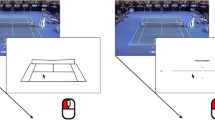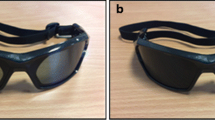Abstract
Visual information is essential to successfully anticipate the direction of the shot in ball sports whereas using another sense in motor learning has received less attention. The present study aimed to examine whether the multisensory learning with the orienting visual attention through the sound would influence anticipatory judgments with respect to the visual system alone. Forty novice students were randomly divided into visual and audio-visual groups. The experimental procedure comprised two phases; 1 training and 3 testing phases, respectively. During the training sessions, 200 video clips were employed to anticipate the direction of the shot, interspersed by 5-min of rest every 25 trials. A sound was used to orient the attention of the audio-visual group toward key points meanwhile the visual group watched the videos without sounds. Then, during the testing phases, they watched 20 video clips in the pretest, immediate retention, and delay retention test. The film was occluded at the racket-ball contact and then they quickly and carefully decided the direction of the shot. The audio-visual group showed higher response accuracy and shorter decision time than the visual group in the immediate and delayed retention. The audio-visual group exhibited longer fixation duration to the key areas than the visual group. In conclusion, using multisensory learning may not only reallocate perceptual and cognitive workload but also could reduce distraction, since, unlike visual perception, auditory perception requires neither specific athlete orientation nor a focus of attention. In general, the use of the multisensory learning is likely to be effective in learning complex motor tasks, facilitating the discovery of the new task needs and helping to perceive the exercise structure.





Similar content being viewed by others
References
Piras A, Lanzoni IM, Raffi M, Persiani M (2016) The within-task criterion to determine successful and unsuccessful table tennis players. Int J Sports Sci Coach 11(4):523–531
Piras A, Raffi M, Perazzolo M, Lanzoni IM (2019) Microsaccades and interest areas during free-viewing sport task. J Sports Sci 37:980–987
Timmis MA, Piras A, van Paridon KN (2018) Keep your eye on the ball; the impact of an anticipatory fixation during successful and unsuccessful soccer penalty kicks. Front Psychol 9:2058
Alder D, Ford PR, Causer J (2014) The coupling between gaze behavior and opponent kinematics during anticipation of badminton shots. Human Movement Sci 37:167–179
Loffing F, Cañal-Bruland RJCOiP (2017) Anticipation in sport, vol 16, pp 6–11
Williams AM, Jackson RCJPoS, Exercise (2019) Anticipation in sport: Fifty years on, what have we learned and what research still needs to be undertaken? vol 42, pp 16–24
Hagemann N, Strauss B (2006) Training perceptual skill by orienting visual attention. J Sport Exercise Psychol 28(2):143–158
Abernethy B (1987) The relationship between expertise and visual search strategy in a racquet sport. Human Movement Sci 6(4):283–319
Prigent E, Hansen C, Baurès R, Darracq C (2015) Predicting where a ball will land: from thrower’s body language to ball’s motion. Exp Brain Res 233(2):567–576
Triolet C, Benguigui N, Le Runigo C (2013) Quantifying the nature of anticipation in professional tennis. J Sports Sci 31(8):820–830
Sáenz-Moncaleano C, Basevitch I (2018) Gaze behaviors during serve returns in tennis: A comparison between intermediate-and high-skill players. J Sport Exercise Psychol 40(2):49–59
Piras A, Raffi M, Lanzoni IM, Persiani M, Squatrito S (2015) Microsaccades and prediction of a motor act outcome in a dynamic sport situation. Invest Ophthalmol Vis Sci 56(8):4520–4530
Piras A, Lobietti R, Squatrito SJJoO (2014) Response time, visual search strategy, and anticipatory skills in volleyball players
Papin JP, Metges PJ, Amalberti RR (1984) Use of NAC eye mark by radiologists. Adv Psychol 22:323–330
Broadbent DP, Causer J, Williams AM (2015) Perceptual-cognitive skill training and its transfer to expert performance in the field: future research directions. Europ J Sport Sci 15(4):322–331
Losing V, Rottkamp L, Zeunert M, Pfeiffer T, editors (2014) Guiding visual search tasks using gaze-contingent auditory feedback. In: Proceedings of the 2014 ACM International Joint Conference on Pervasive and Ubiquitous Computing: Adjunct Publication
Bota A (2017) Multisensory learning in motor activities. Sci Bull Mircea cel Batran Naval Acad 20(1):551
Frid E, Bresin R, Pysander E-LS, Moll JJS, Computing M (2017) An exploratory study on the effect of auditory feedback on gaze behavior in a virtual throwing task with and without haptic feedback, pp 242–249
Cañal-Bruland R, Muller F, Lach B, Spence C (2018) Auditory contributions to visual anticipation in tennis. Psychol Sport Exercise. 36:100–103
Seitz AR, Kim R, Shams LJCB (2006) Sound facilitates visual learning. Current Biol 16(14):1422–1427
Min X, Zhai G, Gao Z, Hu C, Yang X, editors (2014) Sound influences visual attention discriminately in videos. In: 2014 Sixth International Workshop on Quality of Multimedia Experience (QoMEX), IEEE
Klatt S (2020) Visual and auditory information during decision making in sport. J Sport Exercise Psychol 42(1):15–25
Shams L (2008) Benefits of multisensory learning. Trends Cognit Sci 12(11):411–417
Coutrot A, Guyader N, Ionescu G, Caplier A (2012) Influence of soundtrack on eye movements during video exploration
Cañal-Bruland R, Müller F, Lach B (2018) Auditory contributions to visual anticipation in tennis. Psychol Sport Exercise 36:100–103
Abernethy B, Gill DP, Parks SL, Packer STJP (2001) Expertise and the perception of kinematic and situational probability information. Perception 30(2):233–252
Parseihian G, Aramaki M, Ystad S, Kronland-Martinet R, editors (2017) Exploration of sonification strategies for guidance in a blind driving game. In: International symposium on computer music multidisciplinary research, Springer
Abernethy B (1987) Expert-novice differences in an applied selective attention task. J Sport Exercise Psychol 9(4):326–345
Sigrist R, Rauter G, Marchal-Crespo L, Riener R (2015) Sonification and haptic feedback in addition to visual feedback enhances complex motor task learning. Exp Brain Res 233(3):909–925
Sigrist R, Rauter G, Riener R (2013) Augmented visual, auditory, haptic, and multimodal feedback in motor learning: a review. Psychonomic Bull Rev 20(1):21–53
Smeeton NJ, Williams AM, Hodges NJ (2005) The relative effectiveness of various instructional approaches in developing anticipation skill. J Exp Psychol Appl 11(2):98
Dyer JF, Stapleton P (2017) Mapping sonification for perception and action in motor skill learning. Front Neurosci 11:463
Jacobs DM (2007) Direct learning. Ecol Psychol 19(4):321–349
Acknowledgements
We wish to thank athletes and sport students for taking part in the testing. This research received grant from funding agencies in Shahid Beheshti University.
Author information
Authors and Affiliations
Corresponding author
Ethics declarations
Conflict of interest
The authors declare that they have no conflict of interest regarding the publication of this paper.
Additional information
Publisher's Note
Springer Nature remains neutral with regard to jurisdictional claims in published maps and institutional affiliations.
Rights and permissions
About this article
Cite this article
Khalaji, M., Aghdaei, M., Farsi, A. et al. The effect of eye movement sonification on visual search patterns and anticipation in novices. J Multimodal User Interfaces 16, 173–182 (2022). https://doi.org/10.1007/s12193-021-00381-z
Received:
Accepted:
Published:
Issue Date:
DOI: https://doi.org/10.1007/s12193-021-00381-z




